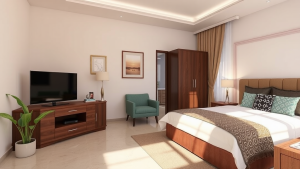Essential accessible home features for retirees: enhancing comfort and safety
As you enter your retirement years, ensuring your home is both comfortable and safe becomes more important than ever. Accessible home features can greatly enhance your quality of life by reducing hazards and simplifying daily tasks. Here’s what you should consider for an accessible living environment.
Walkways and entryways
Having clear and well-maintained walkways is essential. Ensure that:
- Paths are wide enough for mobility aids, such as walkers or wheelchairs.
- There are no tripping hazards, like loose concrete or uneven pavement.
- Ramps are installed in place of stairs, making entry easier and safer.
- Doorways are equipped with lever-style handles instead of traditional knobs for ease of use.
Bathroom accessibility
The bathroom can often pose challenges for seniors. Think about these vital features:
- Grab bars installed near the toilet and in the shower or bathtub for safety.
- A shower seat allows for comfortable and safe bathing.
- A raised toilet seat can help with sitting down and standing up.
- Non-slip mats can prevent falls and provide better footing.
Kitchen modifications
Your kitchen should also adapt to your needs. Consider the following upgrades:
- Lower countertops can make meal prep easier without the need for stretching.
- Pull-out cabinets or shelving can help you reach items without bending or straining.
- Incorporate appliances that are easy to operate, including touch-based controls.
- Use lever faucets that require less strength to operate.
Living room essentials
Your living area should promote relaxation and accessibility. Here’s what to keep in mind:
- Choose furniture with firm cushioning to make sitting and standing easier.
- Install good lighting to reduce the risk of trips and falls.
- Keep frequently used items within easy reach, avoiding high shelves.
- Consider smart home technology that allows you to control lights and appliances with voice commands.
Bedroom adjustments
Creating a restful bedroom environment is crucial for your well-being. Here are essential features:
- A bed at a height that allows for easy access, not too high or too low.
- Bedside rails can provide support while getting in and out of bed.
- Keep a phone within reach for emergencies, preferably a cordless or mobile device.
- Use adjustable lighting to set different moods or make getting around easier at night.
Technology integration
Technology can significantly improve your home’s accessibility. Here are a few ideas to consider:
- Smart home systems allow you to control many aspects of your home with simple voice commands.
- Emergency alert systems can provide peace of mind if you fall or need assistance.
- Telehealth services allow you to consult health professionals without leaving home.
- Smart doorbells and locks enable you to monitor who is at your door remotely.
Outdoor spaces
Don’t forget about outdoor accessibility. Create a safe and inviting space by:
- Ensuring pathways to gardens and porches are smooth and wide.
- Including comfortable seating and shaded areas for relaxation.
- Using raised garden beds to make gardening activities accessible.
- Adding railings to stairs or steps, if any exist in your yard.
By focusing on these essential accessible home features, you can significantly enhance your comfort and safety as you age in your home. Making thoughtful improvements not only reduces the risk of injury but also allows you to enjoy your retirement years to the fullest. Aim for a living environment that supports your independence and enriches your daily life.
Tips for retirees on modifying existing homes for better accessibility
As you move into retirement, ensuring that your home remains a comfortable and safe environment becomes more important than ever. Modifying your existing home to enhance accessibility can greatly improve your quality of life. Here are some practical tips that can help retirees create a more accessible living space.
Step-by-step modifications
Making home adjustments doesn’t have to be overwhelming. Breaking down the process into manageable steps can simplify it:
- Assess Your Needs: This is the first step. Identify specific challenges you might face. This could include mobility issues, difficulty reaching high shelves, or problems with stairs.
- Plan Your Budget: Once you know what you need, estimate how much you can spend. Some modifications can be done gradually, which helps you stay within budget.
- Prioritize Modifications: Determine which modifications will have the most immediate impact on your daily life. Focus on areas such as bathrooms, kitchens, and entrances.
Your front door setup
Accessibility starts right at your front door. Here are a few enhancements to consider:
- Ramps: If you have stairs, installing a ramp can drastically improve accessibility. Ensure it has a gentle slope and non-slip surfaces.
- Wider Doorways: Consider enlarging doorframes to accommodate wheelchairs or walkers. Standard door widths may be limiting over time.
- Electronic Door Openers: These can be particularly helpful if you have limited strength. They can allow you to enter your home without having to struggle with doorknobs.
Bathroom modifications
The bathroom can often be a challenging space for retirees. Implementing some simple modifications can reduce risks and enhance comfort:
- Grab Bars: Install grab bars near the toilet and in the shower to provide support and stability. They come in various styles and can match your bathroom décor.
- Walk-In Tubs: Consider replacing your traditional tub with a walk-in version. They often come equipped with safety features and can make bathing much easier.
- Raised Toilet Seats: A raised seat can help reduce the effort needed to sit or stand.
Kitchen adjustments
The kitchen should be a functional and safe space. Here are some ideas to create a more accessible cooking area:
- Lowered Countertops: If you find it hard to reach your counters, consider lowering them. This makes prepping food easier and can be adapted to your height.
- Pull-Out Shelving: Install shelves that pull out for easier access to pots, pans, and kitchen tools. This minimizes the need to bend down or reach up too high.
- Easy-to-Use Faucets: Replace existing faucets with lever-style ones that are easy to operate, even with reduced grip strength.
Flooring choices
Floors play a significant role in home accessibility. Choosing the right type of flooring can help prevent falls:
- Non-Slip Flooring: Opt for flooring materials that provide a good grip and minimize the risk of slipping, such as rubber or textured vinyl.
- Remove Rugs: Loose rugs can be hazardous. If you have them, consider removing them or securing them with double-sided tape.
- Minimal Transitions: Try to keep transitions between rooms flat to prevent tripping, especially when moving between spaces.
Staying technology-savvy
Use modern technology to enhance the accessibility of your home. Smart home devices can be incredibly beneficial:
- Voice-Activated Assistants: Devices like Amazon Alexa or Google Home can be used to control lights, temperature, and even doors without needing to move around much.
- Smart Light Switches: These can be controlled through your smartphone, making it easier to manage your home’s lighting without stretching or bending.
- Online Monitoring Systems: Consider smart cameras and sensors that provide peace of mind, particularly if you live alone.
Adapting your home for better accessibility doesn’t have to be a daunting project. By carefully considering your needs and implementing these adjustments, you can create a more comfortable and safe living environment in your retirement years. Embrace the changes that suit your lifestyle, and look forward to a home that supports your independence.
As you move into retirement, creating a comfortable and safe living environment should be a priority. Essential accessible home features, such as grab bars, wider doorways, and non-slip flooring, can significantly enhance your quality of life. These modifications not only make daily tasks easier but also promote independence, allowing you to enjoy your retirement years without unnecessary challenges.
If you’re considering modifying your existing home, there are plenty of tips to help you along the way. Start by assessing which areas of your home pose challenges. Simple changes can make a big difference. For instance, adding lever-style door handles and pull-out shelves can transform how easily you navigate your space. Don’t hesitate to seek professional advice to create a tailored plan that meets your unique needs. Experts in aging-in-place design can provide solutions that enhance your home’s overall accessibility.
Investing in your home’s accessibility prepares you for the future, ensuring you can comfortably age in place. Remember, it’s about making thoughtful choices that maximize your independence while minimizing hazards. By taking these steps now, you can create a nurturing environment that supports your well-being and allows you to enjoy everything retirement has to offer. Consider these options as you design your accessible home — it’s not just about enhancing safety; it’s about embracing a lifestyle where you’re free to thrive.
15% discount – stylish 4 bedroom town houses in Arabia Hurghada with balconies under 200k — great for belgian families
19% off – luxury 1 bedroom villas with swimming pools in hadaba Hurghada under 50k — stylish homes for irish winter escapers












